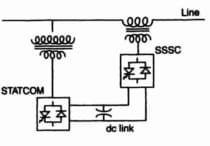1. Power-factor correction usually means the practice of generating ________ as close as possible to the _______ which requires it, rather than supplying it from a remote power station.
a. Active power, load
b. Active power, source
c. Reactive power, load
d. Reactive power, source
2. The supply utilities also have good reasons for not transmitting unnecessary reactive power from generators to loads: their generators and distribution networks cannot be used at _______, and the control of ________in the supply system can become more difficult.
a. Full efficiency, current
b. Full efficiency, voltage
c. Full power, current
d. Full power, voltage
3. The FC-TCR is consist of ________and_________.
a. Fixed capacitor, Fixed inductor
b. Variable capacitor, Fixed inductor
c. Variable capacitor, Variable inductor
d. Fixed capacitor, Variable inductor
4. What is the necessity of compensation?
a. Voltage profile
b. Power angle characteristics
c. Stability margin
d. Damping to power oscillations
e. All of these
5. The objectives of FACTS controllers in the power system network.
a. Better the control of power flow (Real and Reactive) in transmission lines.
b. Limits SC current
c. Increase the load ability of the system
d. a & b
e. a, b & c
6. TCSC is a capacitive reactance compensator, which consists of _______capacitor bank ______ by a thyristor-controlled reactor.
a. shunt, series
b. series, shunted
c. series, series
7. The SVC is a _________ device of FACTS.
a. series
b. series and shunt
c. shunt
8. FACTS mainly find application in following areas.
a. Power transmission
b. Power Quality
c. Railway Grid Connection
d. Wind power grid Connection
e. All of these
9. There are how many generation of FACTS controllers.
a. one
b. Two
c. Three
d. Four
10. __________is the ability of a power system to maintain steady acceptable voltages at all buses in the system under normal operating conditions and after being subjected to a disturbance.
a. voltage stability
b. current stability
c. power stability
d. Transient stability
11. In bypassed mode, the thyristor are made to fully conduct with the conduction angle of ______ degree.
a. 90
b. 180
c. 60
d. 30
12. The salient features of STATCOM are______.
a. Compact size
b. Dynamic response
c. Wide range control
d. a & b
e. a, b & c
13. The third main concern in load compensation is __________.
a. Impedance balancing
b. Current balancing
c. Load balancing
d. Source balancing
14. The ideal compensator would also consume ______ power; that is, it would be ____________.
ANS: Zero average , Lossless
15. Methods of controllable VAR generation in shunt.
ANS : a. Variable impedance type static var generation.
b. Switching converter type static var generation.
16. When Thyristor control reactor(TCR) becomes Thyristor switched reactor(TSR).
a. Alpha = 90
b. Alpha = 0
17. Thyristor Switched Capacitor(TSC) is__________.
a. Switching converter type
b. Variable impedance type
18. Types of Series Compensators.
Ans: a. Variable impedance type Series Compensators
b. Switching converter type Series
Compensators
a. TCR, TSR, TSSC, TSC
b. TSSC, TCSC, SVG, SVS
c. SVG, SVC, TCR, TSR
d. GCSC, TCSC, TSSC
20. List of Static Series compensators.
a. TCR, TSR, TSSC, TSC
b. GCSC, TCSC, TSSC
c. TSSC, TCSC, SVG, SVS
d. SVG, SVC, TCR, TSR
- MCQs on FACTS Page 1
- MCQs on FACTS Page 3
- MCQs on FACTS Page 4
- MCQs on FACTS Page 5
- MCQs on FACTS Page 6
- MCQs on FACTS Page 7
- MCQs on FACTS Page 8





1 Comments
Sir, you saved us...🙏🙏
ReplyDeleteIf you have any doubt, feel free to ask.